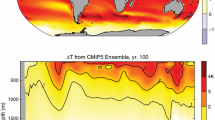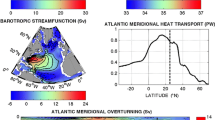Abstract
Conservation of water demands that meridional ocean and atmosphere freshwater transports (FWT) are of equal magnitude but opposite in direction. This suggests that the atmospheric FWT and its associated latent heat (LH) transport could be thought of as a “coupled ocean/atmosphere mode.” But what is the true nature of this coupling? Is the ocean passive or active? Here, we analyze a series of simulations with a coupled ocean-atmosphere-sea ice model employing highly idealized geometries but with markedly different coupled climates and patterns of ocean circulation. Exploiting streamfunctions in specific humidity coordinates for the atmosphere and salt coordinates for the ocean to represent FWT in their respective medium, we find that atmospheric FWT/LH transport is essentially independent of the ocean state. Ocean circulation and salinity distribution adjust to achieve a return freshwater pathway demanded of them by the atmosphere. So, although ocean and atmosphere FWTs are indeed coupled by mass conservation, the ocean is a passive component acting as a reservoir of freshwater.





Similar content being viewed by others
Notes
From Rhines et al. (2008): “Latent heat is fresh water (2.4 PW per Sverdrup), and its transport is an intrinsically coupled ocean/atmosphere mode”
Mass fluxes in the atmosphere and volume fluxes in the (Boussinesq) ocean
References
Adcroft A, Campin JM (2004) Re-scaled height coordinates for accurate representation of free-surface flows in ocean circulation models. Ocean Modell 7:269–284
Adcroft A, Campin J, Hill C, Marshall J (2004) Implementation of an atmosphere-ocean general circulation model on the expanded spherical cube. Mon Wea Rev 132:2845–2863
Bryan K, Lewis LJ (1979) A water mass model of the world ocean. J Geophys Res 84:2503–2517
Bryden H, Imawaki S (2001) Ocean heat transport. In: Siedler G, Church J, Goulds J (eds) Ocean Circulation and Climate. Academic Press, pp 455–474
Campin JM, Marshall J, Ferreira D (2008) Sea ice-ocean coupling using a rescaled vertical coordinate z ∗. Ocean Modell 24:1–14
Czaja A, Marshall JC (2006) The partitioning of poleward heat transport between the atmosphere and ocean. J Atmos Sci 63:1498–1511
Döös K, Nilsson J (2011) Overturning analysis of the meridional energy transport in the atmosphere. J Atmos Sci 68:1806– 1820
Döös K, Webb DJ (1994) The Deacon Cell and the other meridional cells in the Southern Ocean. J Phys Oceanogr 24:429–442
Durack PJ, Wijffels SE (2010) Fifty-year trends in global ocean salinities and their relationship to broad-scale warming. J Climate 23:4342–4362
Enderton D, Marshall J (2009) Explorations of atmosphere-ocean-ice climates on an aqua-planet and their meridional energy transports. J Atmos Sci 66:1593–1611
Ferrari R, Ferreira D (2011) What processes drive the ocean heat transport?. Ocean Modell 38:171–186
Ferreira D, Marshall J, Campin JM (2010) Localization of deep water formation: role of atmospheric moisture transport and geometrical constraints on ocean circulation. J Climate 23:1456–1476
Ferreira D, Marshall J, Rose B (2011) Climate determinism revisited: multiple equilibria in a complex climate model. J Climate 24:992–1012
Ferreira D, Marshall J, Forget G (2015) On the dynamics of the oceanic feshwater transport. In preparation
Forget G, Campin JM, Heimbach P, Hill C, Ponte R, Wunsch C (2015) Ecco version 4: an integrated framework for non-linear inverse modeling and global ocean state estimation. Geoscientific Model Development Submitted
Gent PR, McWilliams JC (1990) Isopycnic mixing in ocean circulation models. J Phys Oceanogr 20:150–155
Held I, Schneider T (1999) The surface branch of the zonally averaged mass transport circulation in the troposphere. J Atmos Sci :56
Held I, Soden BJ (2006) Robust responses of the hydrological cycle to global warming. J Climate 19:5686–5699
Huang RX, Schmitt RW (1993) The goldsbrough-stommel circualtion of the world oceans. J Phys Oceanogr 23:1277–1284
Karoly DJ, McInosth PC, Berrisford P, McDougall TJ, Hirstt AC (1997) Similarity of the Deacon cell in the southern ocean and Ferrel cells in the atmosphere. Quart J Roy Meteor Soc:123
Klinger BA, Marshall J, Send U (1996) Representation of convective plumes by vertical adjustment. J Geophys Res C8(101):18,175–18,182
Ledwell JR, Watson AJ, Law C (1993) Evidence for slow mixing across the pycnocline from an open-ocean tracer-release experiment. Nature 364:701–703
Ledwell JR, St Laurent LC, Girton JB, Toole JM (2011) Diapycnal mixing in the Antarctic Circumpolar Current. J Phys Oceanogr 41:241–246
Lumpkin R, Speer K (2007) Global ocean meridional overturning. J Phys Oceanogr 37:2250–2562
Marshall J, Plumb RA (2008) Atmosphere, Ocean and Climate Dynamics: An Introductory Text, International Geophysics Series, vol 93. Elsevier Academic Press
Marshall J, Adcroft A, Hill C, Perelman L, Heisey C (1997a) A finite-volume, incompressible navier stokes model for studies of the ocean on parallel computers. J Geophys Res 102(C3):5753–5766
Marshall J, Hill C, Perelman L, Adcroft A (1997b) Hydrostatic, quasi-hydrostatic, and nonhydrostatic ocean modeling. J Geophys Res 102(C3):5733–5752
Marshall J, Adcroft A, Campin JM, Hill C, White A (2004) Atmosphere-ocean modeling exploiting fluid isomorphisms. Mon Wea Rev 132:2882–2894
Marshall J, Ferreira D, Campin J, Enderton D (2007) Mean climate and variability of the atmosphere and ocean on an aquaplanet. J Atmos Sci 64:4270–4286
Masson S, Luo JJ, Madec G, Vialard J, Durand F, Gualdi S, Guilyardi E, Behera S, Delecluse P, Navarra A, Yamagata T (2005) Impact of barrier layer on winter-spring variability of the southeastern Arabian Sea. Geophys Res Lett 32:L07,703
Molteni F (2003) Atmospheric simulations using a GCM with simplified physical parametrizations. I: model climatology and variability in multi-decadal experiments. Climate Dyn 64:175–191
Pauluis O, Czaja A, Korty R (2008) The global atmospheric circulation on moist isentropes. Science 321:1075
Polzin KL, Toole JM, Ledwell JR, Schmitt RW (1997) Spatial variability of turbulent mixing in the abyssal ocean. Science 276(5309):93–96
Redi MH (1982) Oceanic isopycnal mixing by coordinate rotation. J Phys Oceanogr 12:1154–1158
Rhines P, Häkkinen S, Josey SA (2008) Is the oceanic heat transport significant in the climate system?. In: Dickson R R et al. (eds) Arctic-Subarctic Ocean Fluxes, Springer, pp 87–109
Saenko OA, Merryfield WJ (2006) Vertical partition of ocean heat transport in isothermal coordinates. Geophys Res Lett 33:L01,606
Talley LD (2008) Freshwater transport estimates and the global overturning circulation: shallow, deep and throughflow components. Prog Oceanogr 78:257–303
Wijffels SE (2001) Ocean freshwater transport. In: Siedler G, Church J, Goulds J (eds) Ocean Circulation and Climate. Academic Press, pp 475–488
Winton M (2000) A reformulated three-layer sea ice model. J Atmos Oceanic Technol 17:525–531
Acknowledgements
The authors would like to thank Richard Greatbatch for advice and encouragements over the years. His openness, wide interest, and enthusiasm for all matters Atmosphere and Ocean is an example to all of us. We thank the Physical Oceanography program of NSF.
Author information
Authors and Affiliations
Corresponding author
Additional information
Responsible Editor: Jinyu Sheng
This article is part of the Topical Collection on Atmosphere and Ocean Dynamics: A Scientific Workshop to Celebrate Professor Dr. Richard Greatbatch’s 60th Birthday, Liverpool, UK, 10-11 April 2014.
Rights and permissions
About this article
Cite this article
Ferreira, D., Marshall, J. Freshwater transport in the coupled ocean-atmosphere system: a passive ocean. Ocean Dynamics 65, 1029–1036 (2015). https://doi.org/10.1007/s10236-015-0846-6
Received:
Accepted:
Published:
Issue Date:
DOI: https://doi.org/10.1007/s10236-015-0846-6




